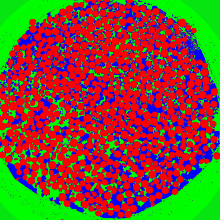New SFB 1313 publication (University of Stuttgart), published in Minerals (MDPI). The work has been developed within the associated SFB 1313 research project C-X2 and SFB 1313 research project C04.
Authors
- Johannes Hommel (University of Stuttgart, SFB 1313 associated research project C-X2)
-
Luca Gehring (Masters' student of the University of Stuttgart)
-
Felix Weinhardt (University of Stuttgart, SFB 1313 research project C04)
-
Matthias Ruf (University of Stuttgart)
- Holger Steeb (University of Stuttgart, SFB 1313 research projects B05, C05, and Z02)
Abstract
Leakage mitigation methods are an important part of reservoir engineering and subsurface fluid storage, in particular. In the context of multi-phase systems of subsurface storage, e.g., subsurface CO2 storage, a reduction in the intrinsic permeability is not the only parameter to influence the potential flow or leakage; multi-phase flow parameters, such as relative permeability and capillary pressure, are key parameters that are likely to be influenced by pore-space reduction due to leakage mitigation methods, such as induced precipitation. In this study, we investigate the effects of enzymatically induced carbonate precipitation on capillary pressure–saturation relations as the first step in accounting for the effects of induced precipitation on multi-phase flow parameters. This is, to our knowledge, the first exploration of the effect of enzymatically induced carbonate precipitation on capillary pressure–saturation relations thus far. First, pore-scale resolved microfluidic experiments in 2D glass cells and 3D sintered glass-bead columns were conducted, and the change in the pore geometry was observed by light microscopy and micro X-ray computed tomography, respectively. Second, the effects of the geometric change on the capillary pressure–saturation curves were evaluated by numerical drainage experiments using pore-network modeling on the pore networks extracted from the observed geometries. Finally, parameters of both the Brooks–Corey and Van Genuchten relations were fitted to the capillary pressure–saturation curves determined by pore-network modeling and compared with the reduction in porosity as an average measure of the pore geometry’s change due to induced precipitation. The capillary pressures increased with increasing precipitation and reduced porosity. For the 2D setups, the change in the parameters of the capillary pressure–saturation relation was parameterized. However, for more realistic initial geometries of the 3D samples, while the general patterns of increasing capillary pressure may be observed, such a parameterization was not possible using only porosity or porosity reduction, likely due to the much higher variability in the pore-scale distribution of the precipitates between the experiments. Likely, additional parameters other than porosity will need to be considered to accurately describe the effects of induced carbonate precipitation on the capillary pressure–saturation relation of porous media.

Johannes Hommel
Dr.-Ing.Associated Project Leader, Research Project C04, Associated Research Project CX2

Felix Weinhardt
Dr.-Ing.Post-doctoral Researcher, Research Project B05

Holger Steeb
Prof. Dr.-Ing.Spokesman, Principal Investigator, Research Projects B05, C05, and Z02, Central Project Z


